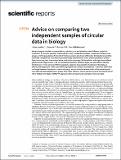Files in this item
Advice on comparing two independent samples of circular data in biology
Item metadata
| dc.contributor.author | Landler, Lukas | |
| dc.contributor.author | Ruxton, Graeme D. | |
| dc.contributor.author | Malkemper, E. Pascal | |
| dc.date.accessioned | 2021-10-14T14:30:09Z | |
| dc.date.available | 2021-10-14T14:30:09Z | |
| dc.date.issued | 2021-10-13 | |
| dc.identifier | 276280655 | |
| dc.identifier | 0658467c-857a-43df-b81c-25d1c942207a | |
| dc.identifier | 85117379852 | |
| dc.identifier | 000707032500072 | |
| dc.identifier.citation | Landler , L , Ruxton , G D & Malkemper , E P 2021 , ' Advice on comparing two independent samples of circular data in biology ' , Scientific Reports , vol. 11 , 20337 . https://doi.org/10.1038/s41598-021-99299-5 | en |
| dc.identifier.issn | 2045-2322 | |
| dc.identifier.other | Jisc: eedcc9b78c5a409fb85476cc970c8452 | |
| dc.identifier.other | publisher-id: s41598-021-99299-5 | |
| dc.identifier.other | manuscript: 99299 | |
| dc.identifier.other | ORCID: /0000-0001-8943-6609/work/101581595 | |
| dc.identifier.uri | https://hdl.handle.net/10023/24140 | |
| dc.description | LL is supported by the Austrian Science Fund (FWF, Grant Number: P32586). EPM receives funding from the European Research Council (ERC) under the European Union’s Horizon 2020 research and innovation program (Grant Agreement No 948728). This research was funded in whole, or in part, by the Austrian Science Fund (FWF) P32586. | en |
| dc.description.abstract | Many biological variables are recorded on a circular scale and therefore need different statistical treatment. A common question that is asked of such circular data involves comparison between two groups: Are the populations from which the two samples are drawn differently distributed around the circle? We compared 18 tests for such situations (by simulation) in terms of both abilities to control Type-I error rate near the nominal value, and statistical power. We found that only eight tests offered good control of Type-I error in all our simulated situations. Of these eight, we were able to identify the Watson’s U2 test and a MANOVA approach, based on trigonometric functions of the data, as offering the best power in the overwhelming majority of our test circumstances. There was often little to choose between these tests in terms of power, and no situation where either of the remaining six tests offered substantially better power than either of these. Hence, we recommend the routine use of either Watson’s U2 test or MANOVA approach when comparing two samples of circular data. | |
| dc.format.extent | 10 | |
| dc.format.extent | 3774863 | |
| dc.language.iso | eng | |
| dc.relation.ispartof | Scientific Reports | en |
| dc.subject | HA Statistics | en |
| dc.subject | QH301 Biology | en |
| dc.subject | DAS | en |
| dc.subject.lcc | HA | en |
| dc.subject.lcc | QH301 | en |
| dc.title | Advice on comparing two independent samples of circular data in biology | en |
| dc.type | Journal article | en |
| dc.contributor.institution | University of St Andrews. School of Biology | en |
| dc.contributor.institution | University of St Andrews. Centre for Biological Diversity | en |
| dc.identifier.doi | https://doi.org/10.1038/s41598-021-99299-5 | |
| dc.description.status | Peer reviewed | en |
This item appears in the following Collection(s)
Items in the St Andrews Research Repository are protected by copyright, with all rights reserved, unless otherwise indicated.

